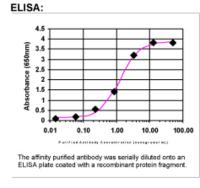CD46 Rabbit Polyclonal Antibody
Other products for "CD46"
Specifications
| Product Data | |
| Applications | ELISA |
| Recommended Dilution | WB: 1:5000-1:20000; ELISA: 1:100-1:2000 |
| Reactivities | Human |
| Host | Rabbit |
| Isotype | IgG |
| Clonality | Polyclonal |
| Immunogen | DNA immunization. This antibody is specific for the C Terminus Region of the target protein. |
| Formulation | 20 mM Potassium Phosphate, 150 mM Sodium Chloride, pH 7.0 |
| Concentration | 1.1mg/ml |
| Purification | Purified from mouse ascites fluids or tissue culture supernatant by affinity chromatography (protein A/G) |
| Conjugation | Unconjugated |
| Storage | Store at -20°C as received. |
| Stability | Stable for 12 months from date of receipt. |
| Gene Name | CD46 molecule |
| Database Link | |
| Background | CD46 (MCP, membrane cofactor protein) is a multifunctional cell surface transmembrane protein that binds and inactivates C3b and C4b complement fragments, regulates T cell-induced inflammatory responses by either inhibiting (CD46-1 isoform) or increasing (CD46-2 isoform) the contact hypersensitivity reaction. CD46 also serves as a receptor for several human pathogens (both bacteria and viruses), and its ligation alteres T lymphocytepolarization toward antigen-presenting cells or target cells, inhibiting lymphocyte function. CD46 is a protector of placental tissue and is also expressed on the inner acrosomal membrane of spermatozoa. |
| Synonyms | AHUS2; MCP; MIC10; TLX; TRA2.10 |
| Note | This antibody was generated by SDIX's Genomic Antibody Technology ® (GAT). Learn about GAT |
| Reference Data | |
| Protein Families | Druggable Genome, Transmembrane |
| Protein Pathways | Complement and coagulation cascades |
Documents
| Product Manuals |
| FAQs |
{0} Product Review(s)
0 Product Review(s)
Submit review
Be the first one to submit a review
Product Citations
*Delivery time may vary from web posted schedule. Occasional delays may occur due to unforeseen
complexities in the preparation of your product. International customers may expect an additional 1-2 weeks
in shipping.






























































































































































































































































 Germany
Germany
 Japan
Japan
 United Kingdom
United Kingdom
 China
China



